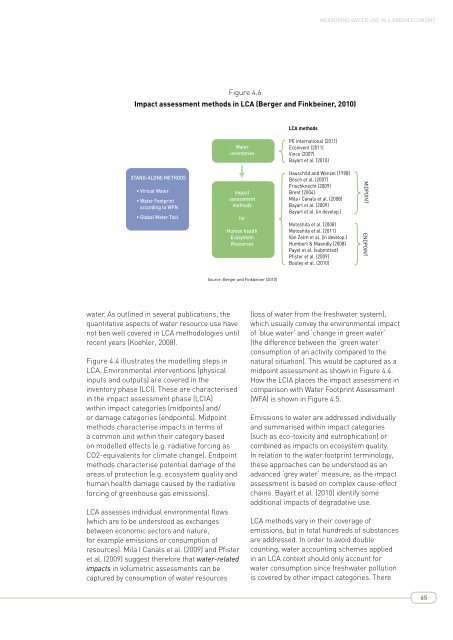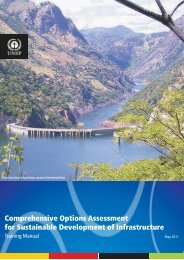MEASURING WATER USE IN A GREEN ECONOMY - UNEP
MEASURING WATER USE IN A GREEN ECONOMY - UNEP
MEASURING WATER USE IN A GREEN ECONOMY - UNEP
Create successful ePaper yourself
Turn your PDF publications into a flip-book with our unique Google optimized e-Paper software.
Measuring water use in a green economy<br />
Figure 4.6<br />
Impact assessment Figure 4.6 methods in LCA<br />
Impact assessment (Berger methods and in Finkbeiner LCA (Berger 2010) and Finkbeiner, 2010)<br />
LCA methods<br />
Water<br />
inventories<br />
PE international (2011)<br />
Ecoinvent (2011)<br />
Vince (2007)<br />
Bayart et al. (2010)<br />
STAND-ALONE METHODS<br />
• Virtual Water<br />
• Water Footprint<br />
according to WFN<br />
• Global Water Tool<br />
Impact<br />
assessment<br />
methods<br />
for<br />
Human health<br />
Ecosystem<br />
Resources<br />
Hauschild and Wenzel (1998)<br />
Bösch et al. (2007)<br />
Frischknecht (2009)<br />
Brent (2004)<br />
Mila i Canals et al. (2008)<br />
Bayart et al. (2009)<br />
Bayart et al. (in develop.)<br />
Motoshita et al. (2008)<br />
Motoshita et al. (2011)<br />
Van Zelm et al. (in develop.)<br />
Humbert & Maendly (2008)<br />
Payet et al. (submitted)<br />
Pfister et al. (2009)<br />
Bouley et al. (2010)<br />
MIDPO<strong>IN</strong>T ENDPO<strong>IN</strong>T<br />
Source: Berger and Finkbeiner (2010)<br />
water. As outlined in several publications, the<br />
quantitative aspects of water resource use have<br />
not ben well covered in LCA methodologies until<br />
recent years (Koehler, 2008).<br />
Figure 4.4 illustrates the modelling steps in<br />
LCA. Environmental interventions (physical<br />
inputs and outputs) are covered in the<br />
inventory phase (LCI). These are characterised<br />
in the impact assessment phase (LCIA)<br />
within impact categories (midpoints) and/<br />
or damage categories (endpoints). Midpoint<br />
methods characterise impacts in terms of<br />
a common unit within their category based<br />
on modelled effects (e.g. radiative forcing as<br />
CO2-equivalents for climate change). Endpoint<br />
methods characterise potential damage of the<br />
areas of protection (e.g. ecosystem quality and<br />
human health damage caused by the radiative<br />
forcing of greenhouse gas emissions).<br />
LCA assesses individual environmental flows<br />
(which are to be understood as exchanges<br />
between economic sectors and nature,<br />
for example emissions or consumption of<br />
resources). Mila I Canals et al. (2009) and Pfister<br />
et al. (2009) suggest therefore that water-related<br />
impacts in volumetric assessments can be<br />
captured by consumption of water resources<br />
(loss of water from the freshwater system),<br />
which usually convey the environmental impact<br />
of ‘blue water’ and ‘change in green water’<br />
(the difference between the ‘green water’<br />
consumption of an activity compared to the<br />
natural situation). This would be captured as a<br />
midpoint assessment as shown in Figure 4.4.<br />
How the LCIA places the impact assessment in<br />
comparison with Water Footprint Assessment<br />
(WFA) is shown in Figure 4.5.<br />
Emissions to water are addressed individually<br />
and summarised within impact categories<br />
(such as eco-toxicity and eutrophication) or<br />
combined as impacts on ecosystem quality.<br />
In relation to the water footprint terminology,<br />
these approaches can be understood as an<br />
advanced ‘grey water’ measure, as the impact<br />
assessment is based on complex cause-effect<br />
chains. Bayart et al. (2010) identify some<br />
additional impacts of degradative use.<br />
LCA methods vary in their coverage of<br />
emissions, but in total hundreds of substances<br />
are addressed. In order to avoid double<br />
counting, water accounting schemes applied<br />
in an LCA context should only account for<br />
water consumption since freshwater pollution<br />
is covered by other impact categories. There<br />
65

















